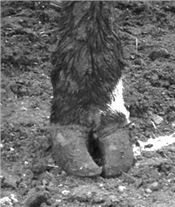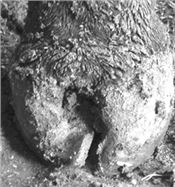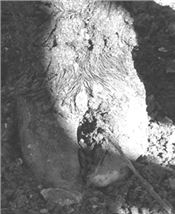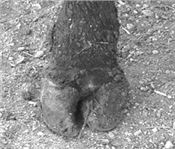|
Work From The Ground Up
DR. TERESA L. STECKLER
SIMPSON, ILL.
“Spring” calving is well underway. Other than hearing reports of cows and calves with pneumonia, it has been relatively quiet thus far. So now is the time to seriously begin considering when to rebreed your cows.
I am not going to discuss EPDs – others can cover that topic. Rather I want to discuss a nagging problem I see in our herds today and the problem is not endemic to any specific breed – structural soundness, i.e. feet and legs. No matter how much time you may have spent on improving marbling, ribeye area, feed efficiency, etc. it will not matter if they become lame!
Each herd has their own selection criteria to produce cattle to meet their herd goals, but selecting cattle that are structurally sound is one goal that all cattlemen should strive for. With cattle prices oscillating and increasing input costs, it becomes very important to select performance oriented cattle that are structurally sound. These cattle will outperform and remain in the herd longer thus saving you money over time.
Foot and leg conformation problems are related to the occurrence of lameness. Some of these problems include legs that are too straight (post-legged) or hocks that are excessively angled (sickle-hocked). Poor foot and leg conformation and clinical lameness are related to decreased foot angle. Measurements of claw shape have indicated there is a high association with the occurrence of claw disorders and lameness.
For the sake of article length, I will only discuss feet. While certain feet abnormalities may be the most easily recognized structural issue, they are unfortunately one of the more complex aspects to consider. When evaluating cattle, look at claw size/volume and toe angle (and don’t forget leg angle side view). First let’s consider claw size, which is a heritable trait.
Look at size of the claw in relation to the bull’s body size; the larger size will be able to dissipate the force incurred by the bull’s weight. The top and bottom claw width is a good predictor for claw size and the size of the claw should not narrow down from the width across the coronary band (the upper limit of the hoof) to the toe.
Toe length will correlate with toe width. The front claws should be equal in size so that the animal’s weight is balanced between the claws. However, the outer claw of the rear feet is consistently larger and wider than the inside claw. Therefore the outer claw bears more weight relative to the inside claw, but overgrowth of the rear outside claw can result in lameness. Most lameness will be in the outer claw of a rear leg.
Toes should be straight as well as the outside wall. The angle of the outside wall should be perpendicular with the bearing surface. Many cattle exhibit an inward curvature of the outside wall and rotation at the toe; many know this as screw claw.
In screw claw, the wall (side) of the hoof bends down and under the claw. When you lift up the foot, the wall is now extended to the bottom and the animal is actually walking on the hoof wall. This leads to lameness as the weight distribution on the foot is incorrect.
There are two identified causes of screw claw – one is genetic and the other is acquired/environment. It is likely that there is an interaction between these two causes such that some cattle are genetically more susceptible to acquiring the condition.
Diagnosing heritable screw claw (autosomal recessive) requires looking at the cow family, the bull, how old the animal is when you first detect it and some other history of the animal. Since it is highly heritable, cattle from cows and/or bulls with screw claw will likely show it at it a relatively young age. If you are certain that they were not over fed at any point in their development, you can probably assume it is genetic.
Now consider toe angle and heel height. The toe angle should be steep; an angle of 50 to 60 degrees is positively correlated with increased cow survival. Also there is a genetic correlation between sole lesions and toe angle. Bulls siring feet with a steeper angle have daughters that live longer. Keep in mind that toe angle is correlated more with cow longevity than leg traits.
There is also a correlation between toe angle and length and heel height. A shallow angle results in a longer toe and lower heels which shifts bearing of weight towards the heel and is associated with more sole ulcers.
Keep in mind the foot should provide a large and stable bearing surface, yet at the same time act as a shock absorber. Both hooves should be of suitable size to bear weight with the claws of approximately equal size and shape. The ideal hoof is free of cracks and other abnormalities and has two symmetrical claws that both point forward.
Also problems with the hoof, such as excessive or uneven toe growth, may be caused by genetic, nutritional (overfeeding and/or mineral deficiencies), or environmental (soft soil surface, lack of exercise, confinement in a restricted area) factors or may be indicative of other concerns the animal may face structurally.
It is important for cattle breeders to select breeding bulls with correct foot and leg conformation to lower the risk of lameness and ensure the welfare of their cattle. So when you attend bull (or female) sales make sure you can see and/or pay attention to the feet and if possible observe the bulls standing and walking on a hard surface. The hard surface may reveal subtle lameness. The bull should walk strong and easy with a flat back. If possible, determine whether the hooves were recently trimmed; if it is a young bull ask why they were trimmed. If you are purchasing a young bull (or heifer) be especially critical since they can remain in the herd a long time. ∆
DR. TERESA L. STECKLER: Extension Specialist, Animal Systems/Beef, Dixon Springs Agricultural Center, University of Illinois

“Examples (primarily screw claw) of poor foot conformation seen in bulls though
Southern Illinois. Some conformation issues are genetic but can exacerbated
by pushing full feed too quickly during the growth phase.”



|
|